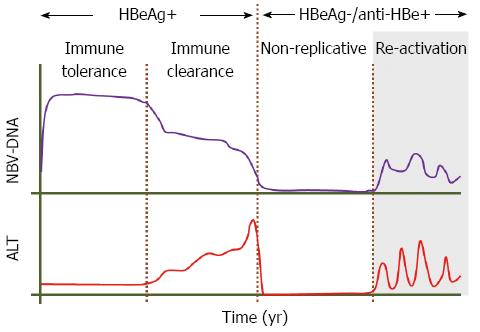Copyright
©2014 Baishideng Publishing Group Inc.
World J Gastroenterol. Jun 28, 2014; 20(24): 7644-7652
Published online Jun 28, 2014. doi: 10.3748/wjg.v20.i24.7644
Published online Jun 28, 2014. doi: 10.3748/wjg.v20.i24.7644
Figure 1 Course of the natural history of hepatitis B virus infection showing the four possible phases of disease.
These are referred to as the immune tolerant, the immune clearance, the non-replicative (inactive) and the reactivation phase characterized by increased viral replication and liver damage (shaded area). During the first two phases the patient is hepatitis B e antigen (HBeAg) positive and negative during the last two. Moreover, the wild type hepatitis B virus (HBV) is dominant in the Immune tolerant and immune clearance phases, whilst the precore and basic core promoter variants are the main isolates seen in patients during the reactivation phase, and such patients constitute the HBeAg negative chronic hepatitis B group. Patients in the immune clearance and the reactivation phases are at greater risk of developing cirrhosis and eventually hepatocellular carcinoma. ALT: Alanine aminotransferase.
- Citation: Alexopoulou A, Karayiannis P. HBeAg negative variants and their role in the natural history of chronic hepatitis B virus infection. World J Gastroenterol 2014; 20(24): 7644-7652
- URL: https://www.wjgnet.com/1007-9327/full/v20/i24/7644.htm
- DOI: https://dx.doi.org/10.3748/wjg.v20.i24.7644









